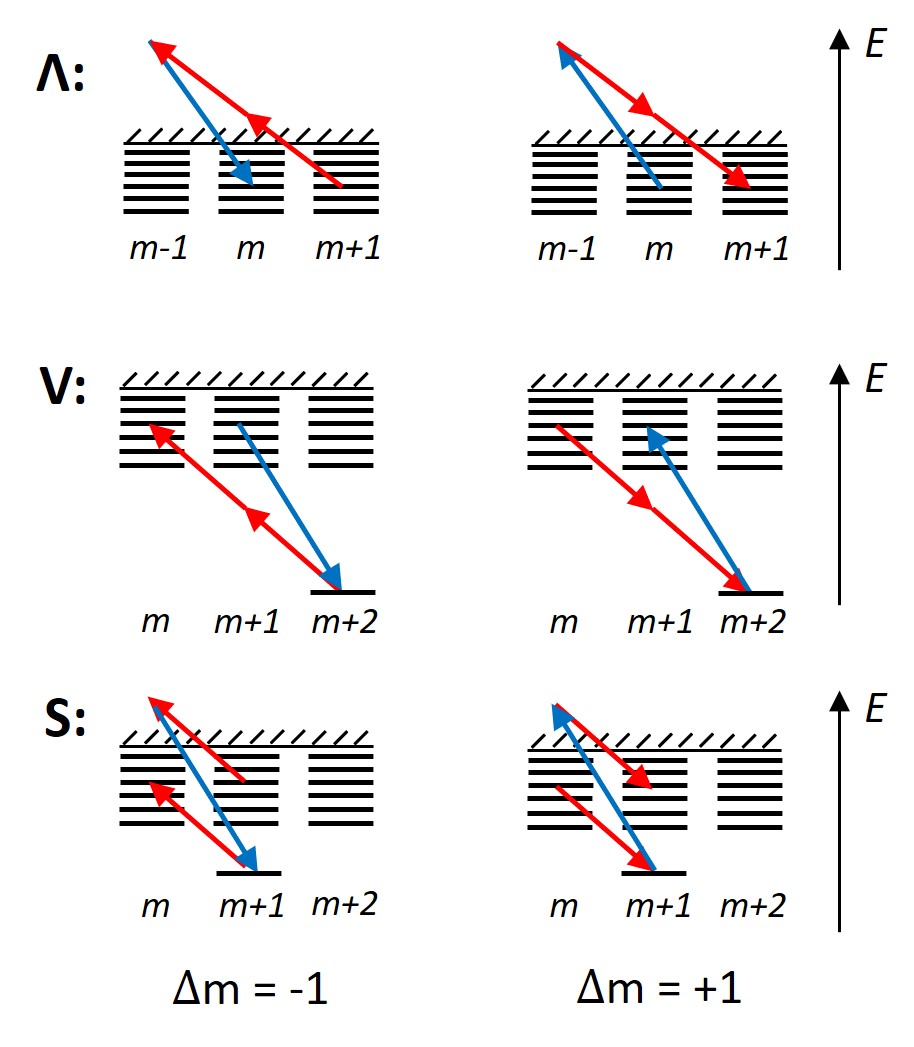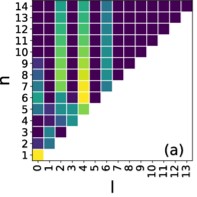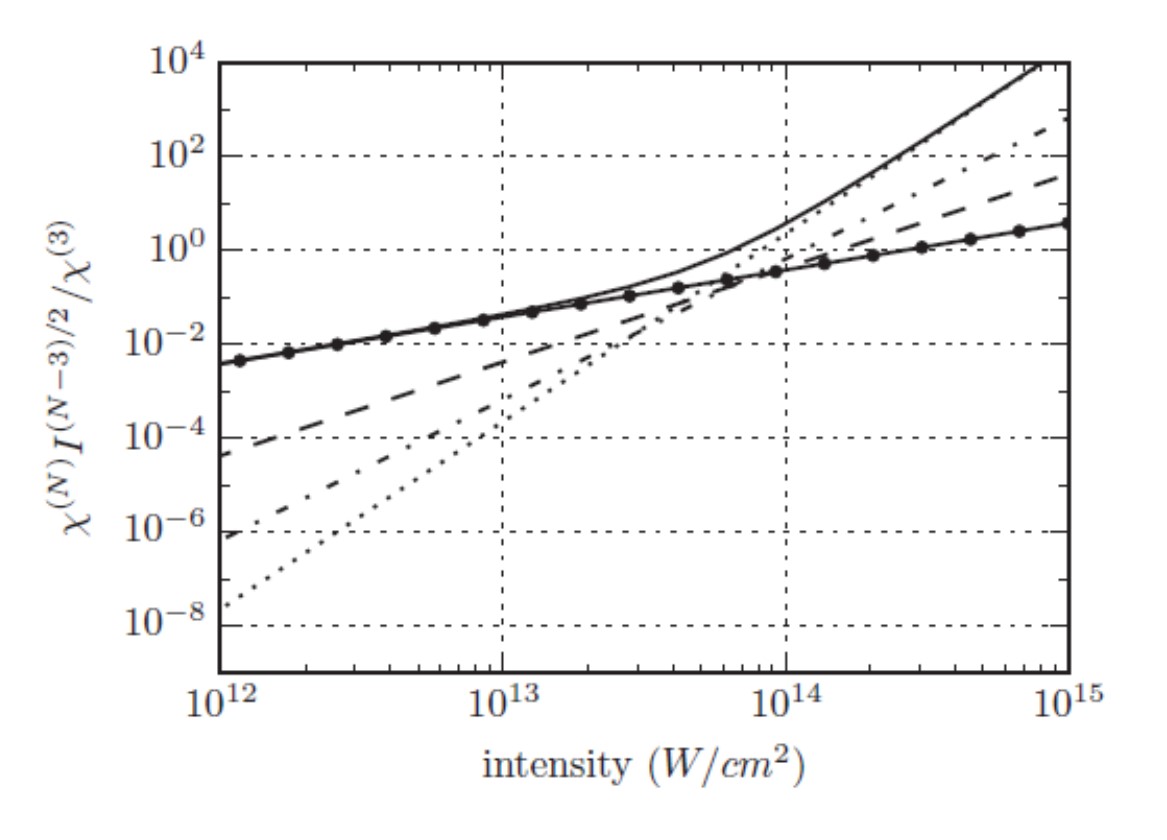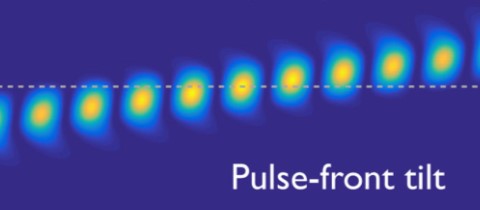Excitation in Bicircular Pulses
 For bichromatic circularly polarized laser pulses the Kapteyn-Murnane group has observed that
the probability to ionize an atom is significantly enhanced if the two fields are
counter-rotating as compared to co-rotating fields, due to the increased density of excited states
accessible for resonant enhanced multiphoton ionization in the case of counter-rotating fields.
Our theoretical study of the excitation pathways reveals that
for co-rotating pulses the distribution
over the magnetic quantum number can be explained via selection rules and higher-order
Raman-like transitions between Rydberg states (see Figure). For pulses with opposite helicities Rydberg
states with magnetic quantum numbers that differ by 3 are predominantly populated. This pattern
provides insights into the relative number of photons absorbed from the two fields.
For bichromatic circularly polarized laser pulses the Kapteyn-Murnane group has observed that
the probability to ionize an atom is significantly enhanced if the two fields are
counter-rotating as compared to co-rotating fields, due to the increased density of excited states
accessible for resonant enhanced multiphoton ionization in the case of counter-rotating fields.
Our theoretical study of the excitation pathways reveals that
for co-rotating pulses the distribution
over the magnetic quantum number can be explained via selection rules and higher-order
Raman-like transitions between Rydberg states (see Figure). For pulses with opposite helicities Rydberg
states with magnetic quantum numbers that differ by 3 are predominantly populated. This pattern
provides insights into the relative number of photons absorbed from the two fields.
J. Venzke, Y. Gebre et al., Phys. Rev. A 101, 053425 (2020).
Y. Gebre et al., Phys. Rev. A 103, 013101 (2021).
Angular Momentum Distributions in Rydberg States
 We have studied the excitation to Rydberg states by a short, strong laser pulse. The
parity of the populated angular momentum states is found to agree with the selection
rules for multiphoton resonant absorption at low intensities, if the pulse length is not
too short. In contrast, the parity effect cannot be observed for ultrashort pulses as
well as for long pulses at high intensities. Signatures of the population in the excited
states via the line emissions from the populated np states after the end of the pulse
exhibiting the parity effect have been identified.
We have studied the excitation to Rydberg states by a short, strong laser pulse. The
parity of the populated angular momentum states is found to agree with the selection
rules for multiphoton resonant absorption at low intensities, if the pulse length is not
too short. In contrast, the parity effect cannot be observed for ultrashort pulses as
well as for long pulses at high intensities. Signatures of the population in the excited
states via the line emissions from the populated np states after the end of the pulse
exhibiting the parity effect have been identified.
J. Venzke et al., Phys. Rev. A 98, 043434 (2018).
PRE 25th Anniversary Milestone
 In 2018 the journal Physical Review E celebrated its 25th anniversary by highlighting a series
of papers that made important contributions to their field. One milestone article for each calendar year since
1993 has been selected by the members of the Editorial Board, in collaboration with the journal's editors. For
2006, our work in collaboration with See Leang Chin and his group on the plasma density inside a femtosecond
laser filament in air is featured as milestone article.
In 2018 the journal Physical Review E celebrated its 25th anniversary by highlighting a series
of papers that made important contributions to their field. One milestone article for each calendar year since
1993 has been selected by the members of the Editorial Board, in collaboration with the journal's editors. For
2006, our work in collaboration with See Leang Chin and his group on the plasma density inside a femtosecond
laser filament in air is featured as milestone article.
F. Theberge et al., Phys. Rev. E 74, 036406 (2006).
featured by Physical Review E as 25th Anniversary Milestone
Breakdown of Power Series Expansion
 For many materials the polarization induced by an external field is found
to be proportional to the field itself. In weak fields the electric
susceptibility as a measure of this proportionality can be expanded
in a power series. We have shown that the perturbative power series
expansion breaks down, as indicated by the ratio of successive terms in the
expansion (see Figure), at about 1x1013 W/cm2.
In the same intensity regime there occurs the transition from perturbative
to non-perturbative interaction in low-order harmonic generation.
At higher intensities ab-initio theory that accounts for the nonperturbative interaction
between the atom and the external field can be used to resolve the change
of the susceptibility as a function of time over the duration of the pulse.
For many materials the polarization induced by an external field is found
to be proportional to the field itself. In weak fields the electric
susceptibility as a measure of this proportionality can be expanded
in a power series. We have shown that the perturbative power series
expansion breaks down, as indicated by the ratio of successive terms in the
expansion (see Figure), at about 1x1013 W/cm2.
In the same intensity regime there occurs the transition from perturbative
to non-perturbative interaction in low-order harmonic generation.
At higher intensities ab-initio theory that accounts for the nonperturbative interaction
between the atom and the external field can be used to resolve the change
of the susceptibility as a function of time over the duration of the pulse.
A. Spott et al., Phys. Rev. A 90, 013426 (2014); 91, 023402 (2015); 96, 053404 (2017).
HHG Control via Angular Spatial Chirp
 We have studied the use of a pulse with angular chirp at the focal plane in high-order harmonic
generation. Results of our numerical simulations show that each harmonic is emitted with an
angular chirp which scales inversely with the harmonic order. This leads to a control of the
separation of the harmonics in two dimensions and the temporal periodicity of the harmonic
pulse trains - in collaboration with Chip Durfee (Colorado School of Mines).
We have studied the use of a pulse with angular chirp at the focal plane in high-order harmonic
generation. Results of our numerical simulations show that each harmonic is emitted with an
angular chirp which scales inversely with the harmonic order. This leads to a control of the
separation of the harmonics in two dimensions and the temporal periodicity of the harmonic
pulse trains - in collaboration with Chip Durfee (Colorado School of Mines).
C. Hernandez-Garcia et al., Phys. Rev. A 93, 023825 (2016)
Past Projects
Imaging of Molecular Dissociation
We studied how electron rearrangement during dissociation of molecules as well as
the expansion of clusters can be imaged via strong-field processes.
A. Picon et al., Phys. Rev. A 83, 013414 (2011)
V. Strelkov et al., Phys. Rev. Lett. 107, 113901 (2011)
W. Li et al., Proc. Nat. Acad. Sciences U.S.A. 107, 20219 (2010)
JILA research highlight:
The Long Goodbye.
From Intensity Clamping to Tunable Pulses
We studied high-harmonic generation as a tool to image molecular
structure on an ultrafast time scale. Theoretical predictions
showed how the radius of a fullerene (C20 to C180)
can be retrieved from the position of characteristic interference minima in the spectrum.
M.F. Ciappina et al., Phys. Rev. A 76, 063406 (2007); 78, 063405 (2008)
Imaging of Fullerenes
We studied high-harmonic generation as a tool to image molecular
structure on an ultrafast time scale. Theoretical predictions
showed how the radius of a fullerene (C20 to C180)
can be retrieved from the position of characteristic interference minima in the spectrum.
M.F. Ciappina et al., Phys. Rev. A 76, 063406 (2007); 78, 063405 (2008)